Evaluating the Relationship Between the Introduction of the Acellular Pertussis Vaccine and Whooping Cough Resurgence in the United States
Abstract
1. Introduction
2. Methods
2.1. Study Design
2.2. Data Sources and Statistical Analysis
2.3. Ethical Considerations
3. Results
3.1. Pertussis Incidence
3.2. Pertussis Vaccine Coverage
4. Discussion
5. Conclusions
Author Contributions
Funding
Institutional Review Board Statement
Informed Consent Statement
Data Availability Statement
Conflicts of Interest
Abbreviations
| DTaP | Diphtheria, Tetanus, Acellular Pertussis |
| DTP | Diphtheria, Tetanus, Pertussis (whole-cell vaccine) |
| Tdap | Tetanus, Diphtheria, Acellular Pertussis |
| CDC | Center for Disease Control and Prevention |
| WHO | World Health Organization |
References
- Centers for Disease Control and Prevention. Pertussis|Whooping Cough|Causes and Transmission|CDC. Available online: https://www.cdc.gov/pertussis/about/index.html (accessed on 1 July 2025).
- Plans-Rubió, P. Evaluation of the Establishment of Herd Immunity in the Population by means of Serological Surveys and Vaccination Coverage. Hum. Vaccines Immunother. 2012, 8, 184–188. [Google Scholar] [CrossRef]
- Centers for Disease Control and Prevention. Pertussis|Whooping Cough|Surveillance|Cases by Year|CDC. Available online: https://www.cdc.gov/pertussis/php/surveillance/pertussis-cases-by-year.html (accessed on 1 July 2025).
- Cody, C.L.; Baraff, L.J.; Cherry, J.D.; Marcy, S.M.; Manclark, C.R. Nature and Rates of Adverse Reactions Associated with DTP and DT Immunizations in Infants and Children. Pediatrics 1981, 68, 650–660. [Google Scholar] [CrossRef]
- Long, S.S.; Deforest, A.; Smith, D.G.; Lazaro, C.; Wassilak, G.F. Longitudinal Study of Adverse Reactions Following Diphtheria-Tetanus-Pertussis Vaccine in Infancy. Pediatrics 1990, 85, 294–302. [Google Scholar] [CrossRef]
- World Health Organization. Diphtheria Tetanus Toxoid and Pertussis (DTP) Vaccination Coverage. Available online: https://immunizationdata.who.int/global/wiise-detail-page/diphtheria-tetanus-toxoid-and-pertussis-(dtp)-vaccination-coverage?CODE=USA&ANTIGEN=DTPCV3&YEAR= (accessed on 20 June 2025).
- Barlow, W.E.; Davis, R.L.; Glasser, J.W.; Rhodes, P.H.; Thompson, R.S.; Mullooly, J.P.; Black, S.B.; Shinefield, H.R.; Ward, J.I.; Marcy, S.M.; et al. The Risk of Seizures after Receipt of Whole-Cell Pertussis or Measles, Mumps, and Rubella Vaccine. N. Engl. J. Med. 2001, 345, 656–661. [Google Scholar] [CrossRef] [PubMed]
- Cowan, L.D.; Griffin, M.R.; Howson, C.P.; Katz, M.; Johnston, R.B., Jr.; Shaywitz, B.A.; Fineberg, H.V. Acute encephalopathy and chronic neurological damage after pertussis vaccine. Vaccine 1993, 11, 1371–1379. [Google Scholar] [CrossRef]
- Centers for Disease Control and Prevention. Pertussis Vaccination: Use of Acellular Pertussis Vaccines Among Infants and Young Children Recommendations of the Advisory Committee on Immunization Practices (ACIP); Centers for Disease Control and Prevention: Atlanta, GA, USA, 1997. [Google Scholar]
- Clark, T.A.; Messonnier, N.E.; Hadler, S.C. Pertussis Control: Time for Something New? Trends Microbiol. 2012, 20, 211–213. [Google Scholar] [CrossRef]
- Clark, T.A. Changing Pertussis Epidemiology: Everything Old is New Again. J. Infect. Dis. 2014, 209, 978–981. [Google Scholar] [CrossRef]
- Salmaso, S.; Mastrantonio, P.; Tozzi, A.E.; Stefanelli, P.; Anemona, A.; Ciofi degli Atti, M.L.; Giammanco, A.; Stage, I.I.I.W.G. Sustained Efficacy during the First 6 years of life of 3-component Acellular Pertussis Vaccines Administered in Infancy: The Italian Experience. Pediatrics 2001, 108, E81. [Google Scholar] [CrossRef] [PubMed]
- Skoff, T.H.; Cohn, A.C.; Clark, T.A.; Messonnier, N.E.; Martin, S.W. Early Impact of the US Tdap Vaccination Program on Pertussis Trends. Arch. Pediatr. Adolesc. Med. 2012, 166, 344–349. [Google Scholar] [CrossRef] [PubMed]
- Hung, M.-C.; Srivastav, A.; Lu, P.-j.; Black, C.; Lindley, M.C.; Singleton, J.A. Vaccination Coverage Among Adults in the United States, National Health Interview Survey. 2022. Available online: https://www.cdc.gov/adultvaxview/publications-resources/adult-vaccination-coverage-2022.html (accessed on 6 July 2025).
- Lu, P.J.; O’Halloran, A.; Ding, H.; Liang, J.L.; Williams, W.W. National and State-Specific Td and Tdap Vaccination of Adult Populations. Am. J. Prev. Med. 2016, 50, 616–626. [Google Scholar] [CrossRef]
- Hill, H.A.; Elam-Evans, L.D.; Yankey, D.; Singleton, J.A.; Dietz, V. Vaccination Coverage Among Children Aged 19-35 Months—United States, 2015. MMWR. Morb. Mortal. Wkly. Rep. 2016, 65, 1065–1071. [Google Scholar] [CrossRef] [PubMed]
- Centers for Disease Control and Prevention. Reported Pertussis Incidence by Age Group and Year|CDC. Available online: https://www.cdc.gov/pertussis/php/surveillance/pertussis-incidence-by-age-group-and-year.html (accessed on 6 July 2025).
- Wang, S.; Zhang, S.; Liu, J. Resurgence of pertussis: Epidemiological trends, contributing factors, challenges, and recommendations for vaccination and surveillance. Hum. Vaccines Immunother. 2025, 21, 2513729. [Google Scholar] [CrossRef]
- Locht, C. Pertussis before, during and after Covid-19. EMBO Mol. Med. 2025, 17, 594–598. [Google Scholar] [CrossRef]
- Bricks, L.F.; Vargas-Zambrano, J.C.; Macina, D. Epidemiology of Pertussis After the COVID-19 Pandemic: Analysis of the Factors Involved in the Resurgence of the Disease in High-, Middle-, and Low-Income Countries. Vaccines 2024, 12, 1346. [Google Scholar] [CrossRef]
- Gambhir, M.; Clark, T.A.; Cauchemez, S.; Tartof, S.Y.; Swerdlow, D.L.; Ferguson, N.M. A change in vaccine efficacy and duration of protection explains recent rises in pertussis incidence in the United States. PLoS Comput. Biol. 2015, 11, e1004138. [Google Scholar] [CrossRef] [PubMed]
- Damron, F.H.; Barbier, M.; Dubey, P.; Edwards, K.M.; Gu, X.X.; Klein, N.P.; Lu, K.; Mills, K.H.G.; Pasetti, M.F.; Read, R.C.; et al. Overcoming Waning Immunity in Pertussis Vaccines: Workshop of the National Institute of Allergy and Infectious Diseases. J. Immunol. 2020, 205, 877–882. [Google Scholar] [CrossRef]
- Hall, J.M.; Gutiérrez-Ferman, J.L.; Shamseldin, M.M.; Guo, M.; Gupta, Y.A.; Deora, R.; Dubey, P. Opposing effects of acellular and whole cell pertussis vaccines on Bordetella pertussis biofilm formation, Siglec-F+ neutrophil recruitment and bacterial clearance in mouse nasal tissues. bioRxiv 2024. [Google Scholar] [CrossRef]
- Warfel, J.M.; Zimmerman, L.I.; Merkel, T.J. Acellular pertussis vaccines protect against disease but fail to prevent infection and transmission in a nonhuman primate model. Proc. Natl. Acad. Sci. USA 2014, 111, 787–792. [Google Scholar] [CrossRef]
- Wilk, M.M.; Borkner, L.; Misiak, A.; Curham, L.; Allen, A.C.; Mills, K.H.G. Immunization with whole cell but not acellular pertussis vaccines primes CD4 T(RM) cells that sustain protective immunity against nasal colonization with Bordetella pertussis. Emerg. Microbes Infect. 2019, 8, 169–185. [Google Scholar] [CrossRef] [PubMed]
- Mooi, F.R.; Van Der Maas, N.a.T.; De Melker, H.E. Pertussis Resurgence: Waning Immunity and Pathogen Adaptation—Two Sides of the Same Coin. Epidemiol. Infect. 2014, 142, 685–694. [Google Scholar] [CrossRef]
- Schmidtke, A.J.; Boney, K.O.; Martin, S.W.; Skoff, T.H.; Tondella, M.L.; Tatti, K.M. Population Diversity among Bordetella pertussis Isolates, United States, 1935–2009. Emerg. Infect. Dis. 2012, 18, 1248–1255. [Google Scholar] [CrossRef] [PubMed]
- Barkoff, A.-M.; Mertsola, J.; Guillot, S.; Guiso, N.; Berbers, G.; He, Q. Appearance of Bordetella pertussis Strains not Expressing the Vaccine Antigen Pertactin in Finland. Clin. Vaccine Immunol. CVI 2012, 19, 1703–1704. [Google Scholar] [CrossRef]
- Bodilis, H.; Guiso, N. Virulence of Pertactin-Negative Bordetella pertussis Isolates from Infants, France. Emerg. Infect. Dis. 2013, 19, 471–474. [Google Scholar] [CrossRef] [PubMed]
- Ma, L.; Caulfield, A.; Dewan, K.K.; Harvill, E.T. Pertactin-Deficient Bordetella pertussis, Vaccine-Driven Evolution, and Reemergence of Pertussis. Emerg. Infect. Dis. 2021, 27, 1561–1566. [Google Scholar] [CrossRef]
- Queenan, A.M.; Cassiday, P.K.; Evangelista, A. Pertactin-negative Variants of Bordetella pertussis in the United States. N. Engl. J. Med. 2013, 368, 583–584. [Google Scholar] [CrossRef]
- Calhoun, K.; Kahn, K.E.; Razzaghi, H.; Garacci, E.; Lindley, M.; Black, C. Association of Vaccine Hesitancy with Maternal Influenza and Tdap Vaccination Coverage—United States, 2019–20 to 2022–23. Available online: https://www.cdc.gov/fluvaxview/coverage-by-season/pregnant-2022-2023.html (accessed on 2 July 2025).
- Razzaghi, H.; Kahn, K.E.; Calhoun, K.; Garacci, E.; Skoff, T.H.; Ellington, S.R.; Jatlaoui, T.C.; Black, C.L. Influenza, Tdap, and COVID-19 Vaccination Coverage and Hesitancy Among Pregnant Women—United States, April 2023. MMWR Morb. Mortal. Wkly. Rep. 2023, 72, 1065–1071. [Google Scholar] [CrossRef]
- Masseria, C.; Martin, C.K.; Krishnarajah, G.; Becker, L.K.; Buikema, A.; Tan, T.Q. Incidence and Burden of Pertussis Among Infants Less Than 1 Year of Age. Pediatr. Infect. Dis. J. 2017, 36, e54–e61. [Google Scholar] [CrossRef]
- Sansone, N.M.S.; Boschiero, M.N.; Marson, F.A.L. The 2024 resurgence of Bordetella pertussis in Brazil and a decade-long epidemiological overview. Front. Public Health 2025, 13, 1549735. [Google Scholar] [CrossRef] [PubMed]
- Zerbo, O.; Fireman, B.; Klein, N.P. Lessons from a mature acellular pertussis vaccination program and strategies to overcome suboptimal vaccine effectiveness. Expert Rev. Vaccines 2022, 21, 899–907. [Google Scholar] [CrossRef]
- Liko, J.; Robison, S.G.; Cieslak, P.R. Priming with Whole-cell versus Acellular Pertussis Vaccine. N. Engl. J. Med. 2013, 368, 581–582. [Google Scholar] [CrossRef]
- Sheridan, S.L.; Ware, R.S.; Grimwood, K.; Lambert, S.B. Number and order of whole cell pertussis vaccines in infancy and disease protection. JAMA 2012, 308, 454–456. [Google Scholar] [CrossRef] [PubMed]
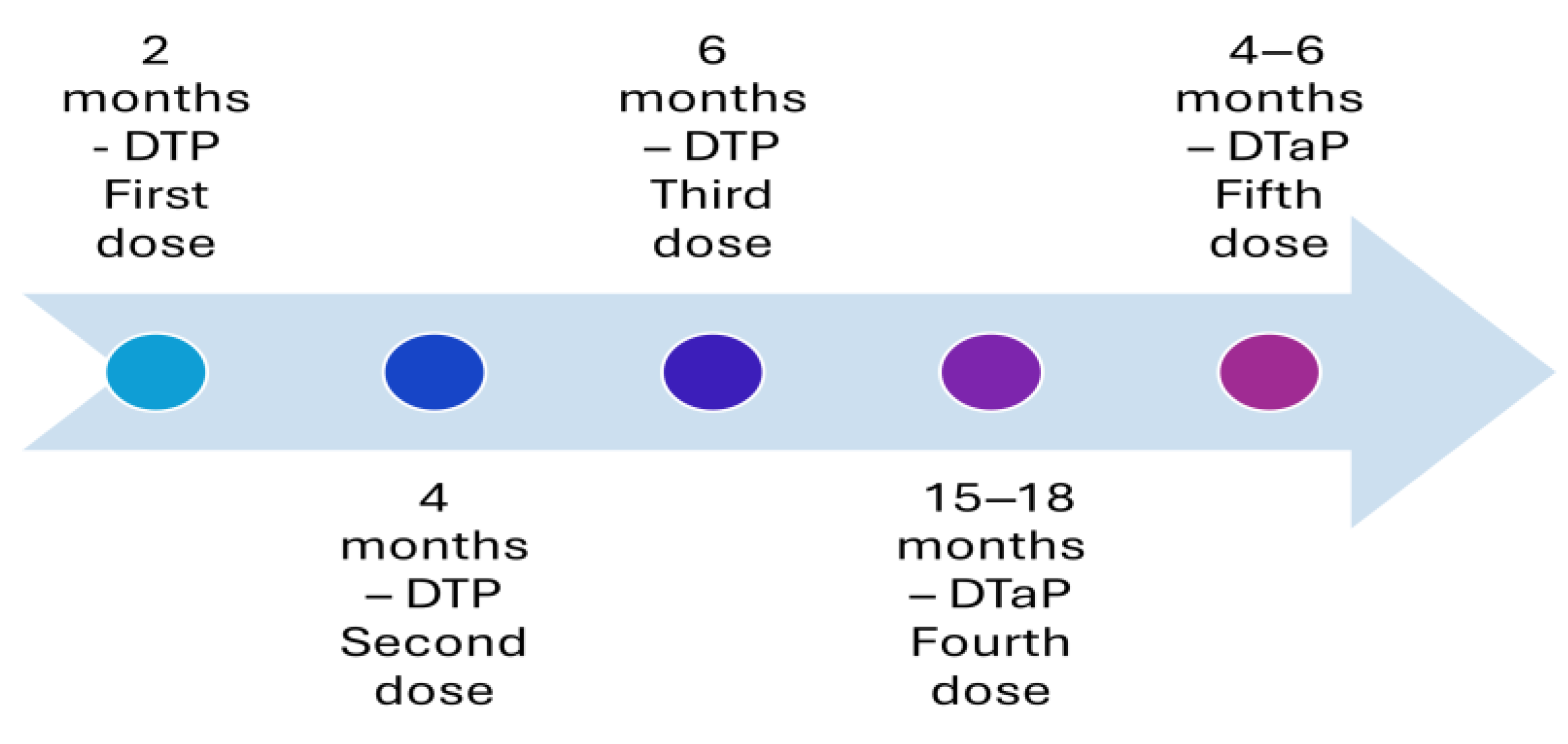
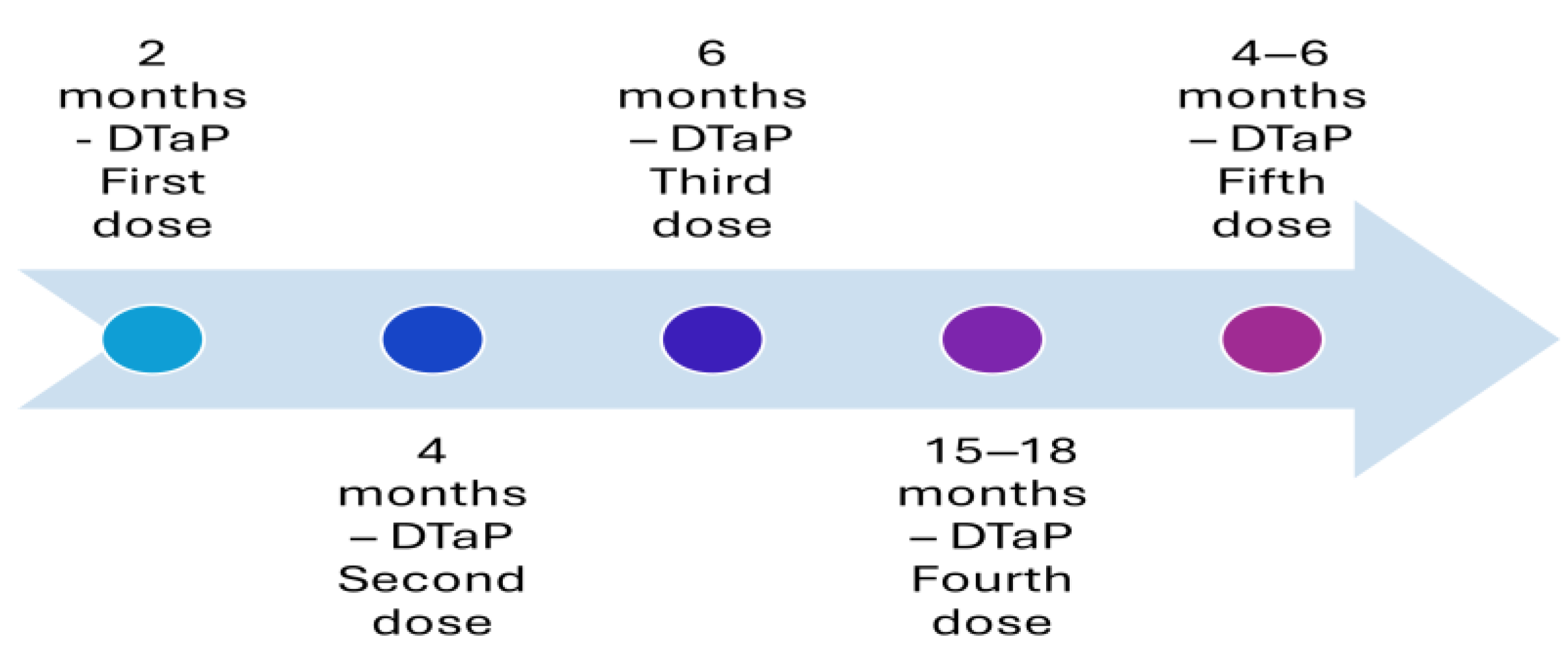

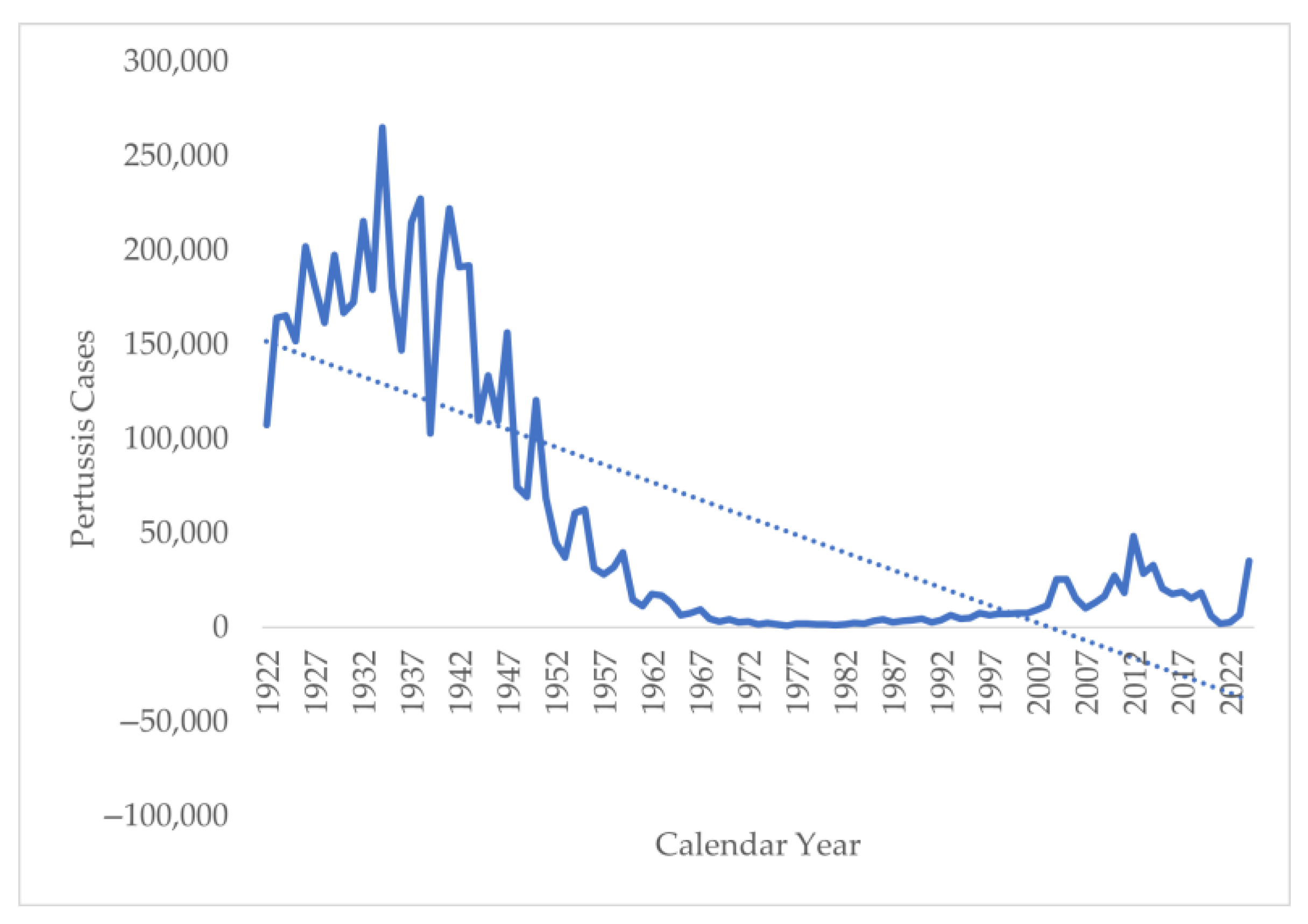
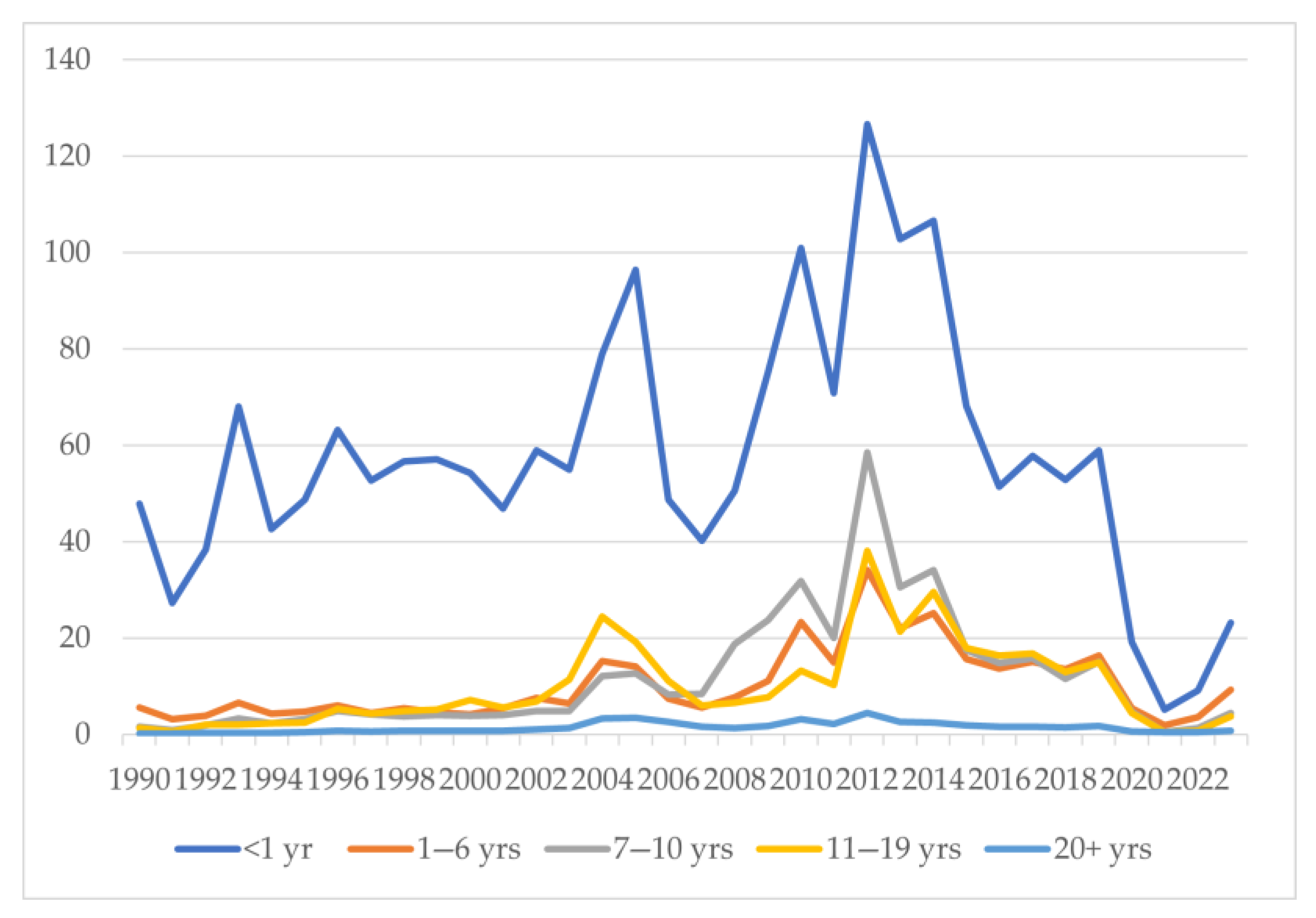
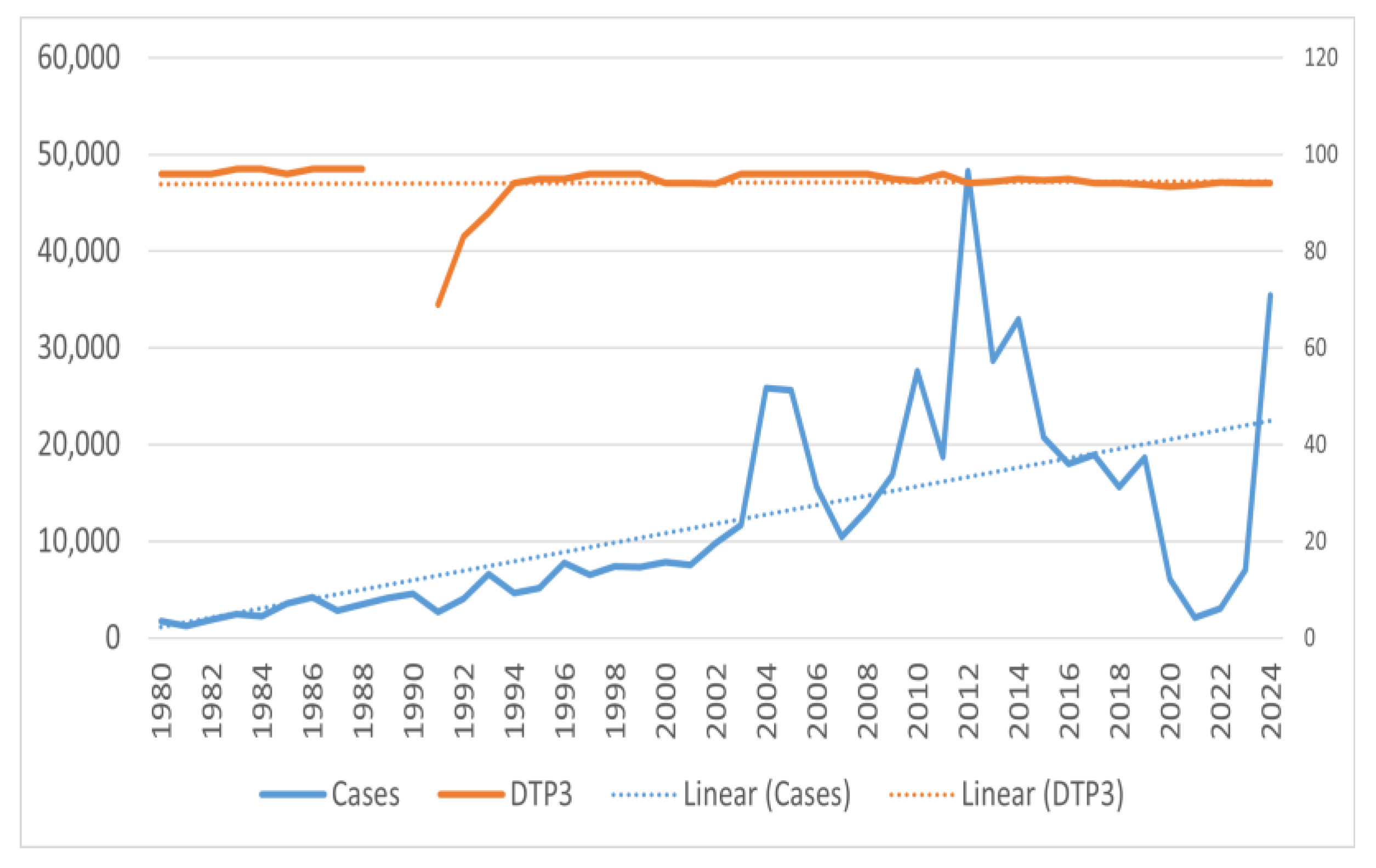
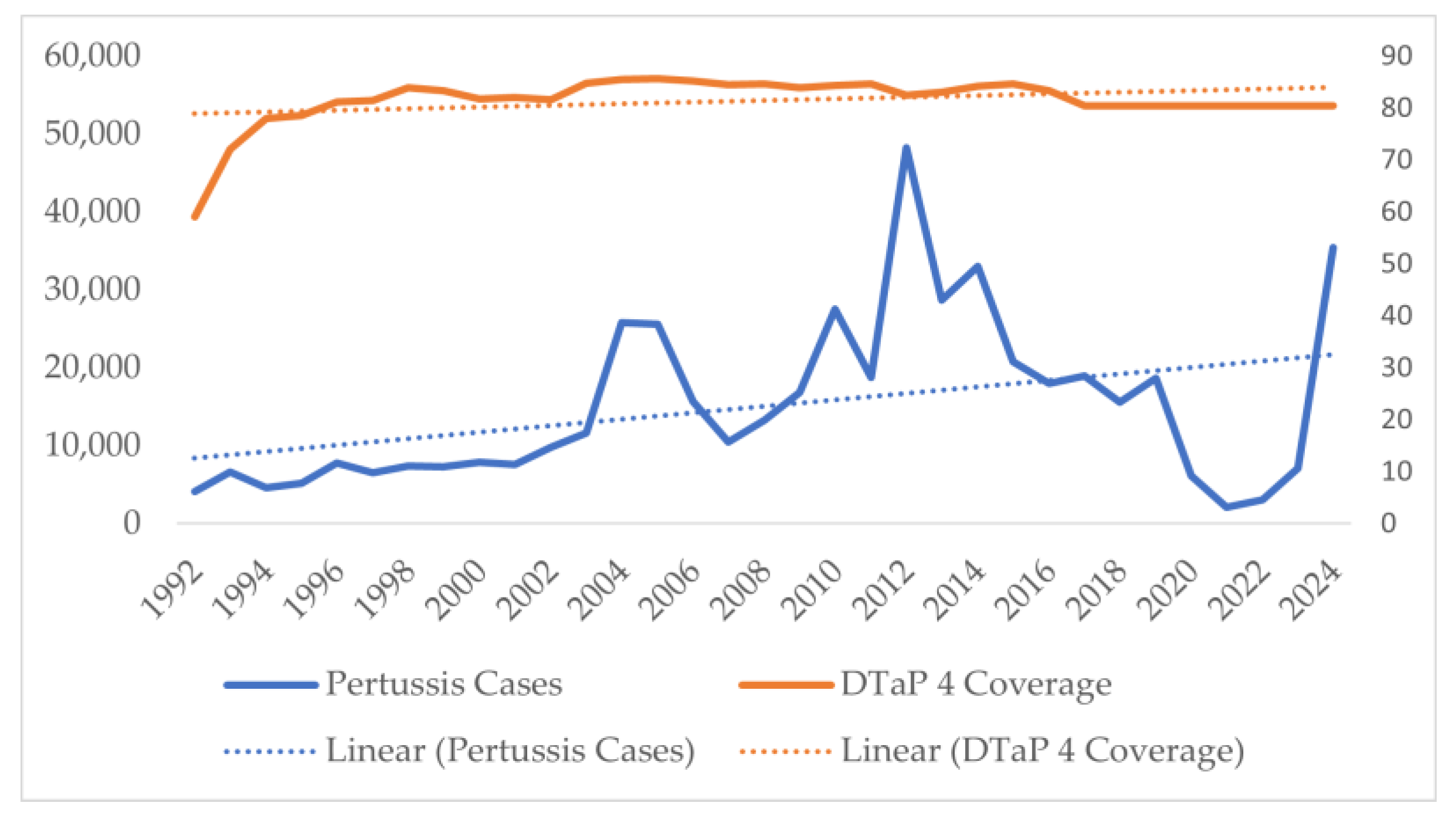

| Year | <1 yr | 1–6 yrs | 7–10 yrs | 11–19 yrs | 20+ yrs |
|---|---|---|---|---|---|
| 1990 | 47.89 | 5.57 | 1.68 | 1.38 | 0.19 |
| 1991 | 27.27 | 3.2 | 0.96 | 0.58 | 0.14 |
| 1992 | 38.41 | 3.93 | 1.95 | 1.99 | 0.27 |
| 1993 | 68 | 6.59 | 3.26 | 2.08 | 0.33 |
| 1994 | 42.61 | 4.35 | 2.26 | 2.3 | 0.27 |
| 1995 | 48.74 | 4.71 | 3.17 | 2.41 | 0.42 |
| 1996 | 63.23 | 6.07 | 4.81 | 5.25 | 0.72 |
| 1997 | 52.73 | 4.49 | 4.23 | 4.33 | 0.66 |
| 1998 | 56.71 | 5.45 | 3.8 | 4.88 | 0.78 |
| 1999 | 57.12 | 4.57 | 3.98 | 5.17 | 0.74 |
| 2000 | 54.23 | 4.15 | 3.9 | 7.08 | 0.74 |
| 2001 | 46.84 | 5.49 | 4.09 | 5.58 | 0.79 |
| 2002 | 59.01 | 7.53 | 4.94 | 6.8 | 1.08 |
| 2003 | 54.98 | 6.41 | 4.81 | 11.34 | 1.32 |
| 2004 | 79 | 15.28 | 12.07 | 24.5 | 3.29 |
| 2005 | 96.47 | 14.15 | 12.64 | 19.17 | 3.5 |
| 2006 | 48.78 | 7.47 | 8.32 | 11.05 | 2.63 |
| 2007 | 40.25 | 5.64 | 8.48 | 6.02 | 1.57 |
| 2008 | 50.54 | 7.67 | 18.85 | 6.58 | 1.35 |
| 2009 | 75.23 | 11.16 | 23.76 | 7.75 | 1.73 |
| 2010 | 100.9 | 23.27 | 31.78 | 13.3 | 3.15 |
| 2011 | 70.89 | 15.02 | 20.05 | 10.26 | 2.15 |
| 2012 | 126.65 | 34.09 | 58.52 | 38.02 | 4.51 |
| 2013 | 102.77 | 22.09 | 30.61 | 21.27 | 2.61 |
| 2014 | 106.68 | 25.14 | 34.04 | 29.57 | 2.5 |
| 2015 | 68.1 | 15.6 | 17.45 | 17.9 | 1.9 |
| 2016 | 51.41 | 13.65 | 14.84 | 16.31 | 1.68 |
| 2017 | 57.78 | 15.16 | 15.79 | 16.83 | 1.68 |
| 2018 | 52.8 | 13.5 | 11.6 | 13 | 1.4 |
| 2019 | 59 | 16.31 | 15.05 | 15.01 | 1.78 |
| 2020 | 19.25 | 5.39 | 4.7 | 4.46 | 0.68 |
| 2021 | 5.22 | 1.94 | 0.46 | 0.45 | 0.49 |
| 2022 | 9.07 | 3.64 | 1.3 | 0.79 | 0.54 |
| 2023 | 23.16 | 9.22 | 4.52 | 3.75 | 0.76 |
| Vaccine Types | Beta Estimate | p-Value |
|---|---|---|
| Whole-Cell Vaccine | Reference | |
| Acellular Pertussis Vaccine (1992–2005) | 7206.6 | 0.058 |
| Acellular Pertussis Vaccine with Tdap Booster (2005–2024) | 16,096.2 | 0.00001 |
Disclaimer/Publisher’s Note: The statements, opinions and data contained in all publications are solely those of the individual author(s) and contributor(s) and not of MDPI and/or the editor(s). MDPI and/or the editor(s) disclaim responsibility for any injury to people or property resulting from any ideas, methods, instructions or products referred to in the content. |
© 2025 by the authors. Licensee MDPI, Basel, Switzerland. This article is an open access article distributed under the terms and conditions of the Creative Commons Attribution (CC BY) license (https://creativecommons.org/licenses/by/4.0/).
Share and Cite
Parikh, J.; Hoare, I.; Izurieta, R. Evaluating the Relationship Between the Introduction of the Acellular Pertussis Vaccine and Whooping Cough Resurgence in the United States. Vaccines 2025, 13, 841. https://doi.org/10.3390/vaccines13080841
Parikh J, Hoare I, Izurieta R. Evaluating the Relationship Between the Introduction of the Acellular Pertussis Vaccine and Whooping Cough Resurgence in the United States. Vaccines. 2025; 13(8):841. https://doi.org/10.3390/vaccines13080841
Chicago/Turabian StyleParikh, Jeegan, Ismael Hoare, and Ricardo Izurieta. 2025. "Evaluating the Relationship Between the Introduction of the Acellular Pertussis Vaccine and Whooping Cough Resurgence in the United States" Vaccines 13, no. 8: 841. https://doi.org/10.3390/vaccines13080841
APA StyleParikh, J., Hoare, I., & Izurieta, R. (2025). Evaluating the Relationship Between the Introduction of the Acellular Pertussis Vaccine and Whooping Cough Resurgence in the United States. Vaccines, 13(8), 841. https://doi.org/10.3390/vaccines13080841







